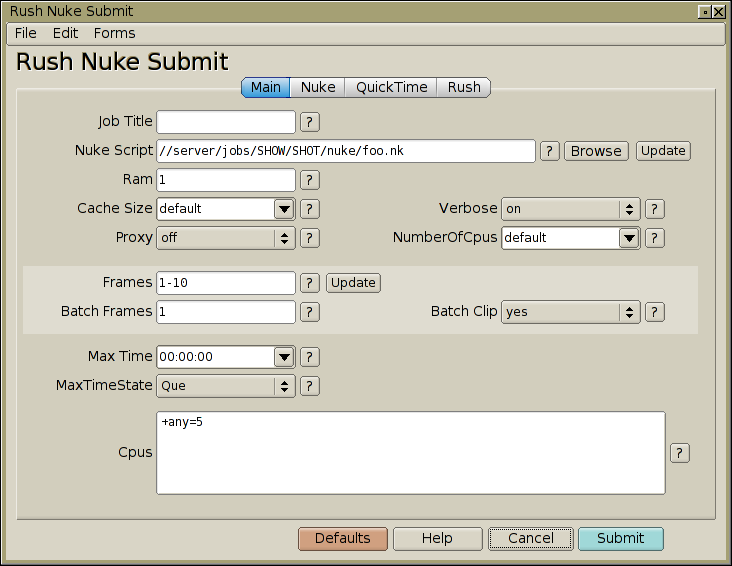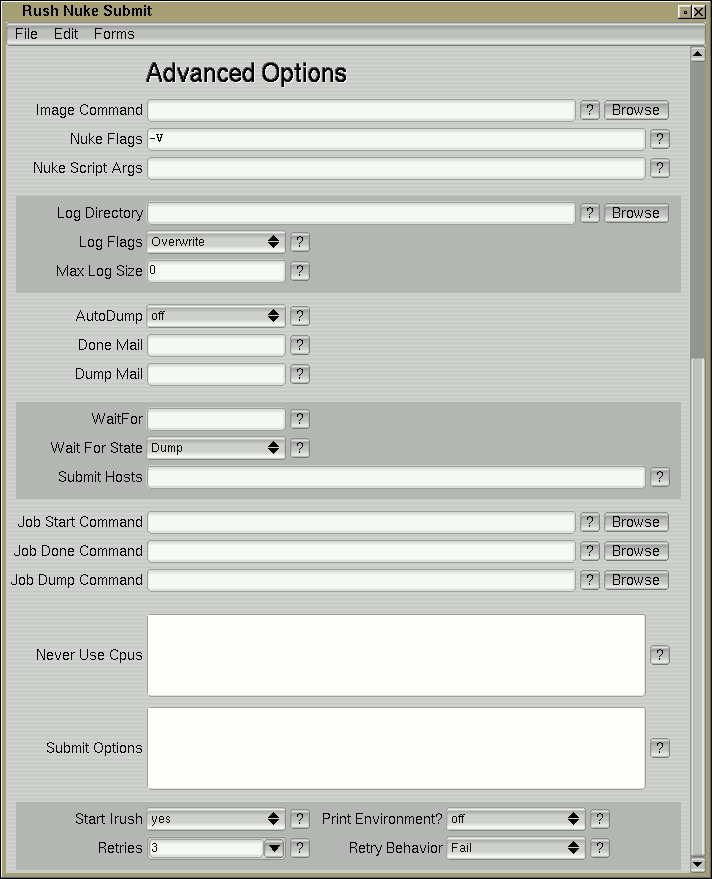

This is something only your sysadmin, or the person installing Rush for the first time should have to do during initial setup. Users should skip down to Making A Desktop Shortcut.
This should have already been set up by your sysadmin, or the person who installed the rush software:
This script will be executed not only by the user to bring up the submit-nuke GUI, but it will also be executed on all the render machines to run the renders.
To ensure the renders run with the proper environment, you'll need to add some lines at the top of the script to set this up. At minimum, you'll need to add nuke's bin directory to the PATH.
Again, this is something only your sysadmin should have to set up.
In the following example, you would modify the pathnames highlighted in red for the version of Nuke you're running:
if ( $G::iswindows )
{
### WINDOWS
$ENV{PATH} = "c:/Program Files/D2Software/nuke4/bin;$ENV{PATH}";
}
elsif ( $G::ismac )
{
### MAC
# $ENV{PATH} = "/Applications/D2Software/nuke4/bin:$ENV{PATH}";
}
elsif ( $G::islinux )
{
### LINUX
$ENV{PATH} = "/usr/local/D2Software/nuke4:$ENV{PATH}";
}
|
Nuke may also depend on other variables; you can define them similarly.
Your systems administrator should have already installed a copy of all the submit scripts on your file server; contact that person to find the location of where the scripts are installed, so you can use the following steps to make a desktop shortcut to them.
Be sure the shortcut points to a copy on a file server, and not to a local copy on your desktop, and not to the local files in c:\rush\examples (windows) or /usr/local/rush/examples (unix).
Should be as simple as clicking on your desktop shortcut.
If you prefer using a terminal window, be sure to run the script with an absolute UNC path, eg:
perl //server/jobs/rushscripts/perl/submit-nuke.plIf you don't run it with an absolute path, the frames will fail because rush didn't have the absolute path to the submit script.
The interface should pop up. If it doesn't, verify (unix) the first line in the script's path points to the correct location of your perl binary, or (windows) the '.pl' extension is configured to correctly invoke perl.
Click the help button (buttons with '?') for any field you want to know more about.
When the GUI pops up, note there are various 'Advanced Options' available if you either scroll the window down, or click on tabs, depending on the script you're using.
It is assumed you are able to bring up the submit script from a desktop shortcut.
This should be an absolute path that must be able to resolve on all the machines you'll be rendering on.
Under Windows, you should use UNC absolute pathnames, such as //server/jobs/LOGO/sc4a/nuke/sc4a.nk
This is the range of frames you want to render; normally two values separated by a dash, eg. '1-100'.
You can also specify individual frames, multiple ranges, or cobinations of both, eg. '1 10 20-30 400-900', which would render frames 1, 10, 20 through 30, and 400 through 900.
In our case, lets use any 5 available cpus at the lowest priority:
+any=5@1
"Advanced Options" are not normally needed, but to see them, use the scroll bar to scroll down to check their settings.
Click the help button (buttons with '?') for any field you want to know more about.
This should submit your job, and a window indicating the jobid should pop up, followed by an irush interface with the jobid already set to the new job.
The next time you bring up the submit form, it will have all the values set from the last execution. Note that you can then save this as a form so you can easily recall it later.
For more info on the irush interface, see the irush tutorial.
Hit 'Frames' in irush to watch the progress of your job.
If some frames are running, or got done already, click on
some, and hit 'Logs' to see the output of the perl commands
you entered.
When you're finished with the job, hit 'Dump' in irush.
